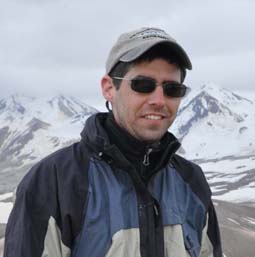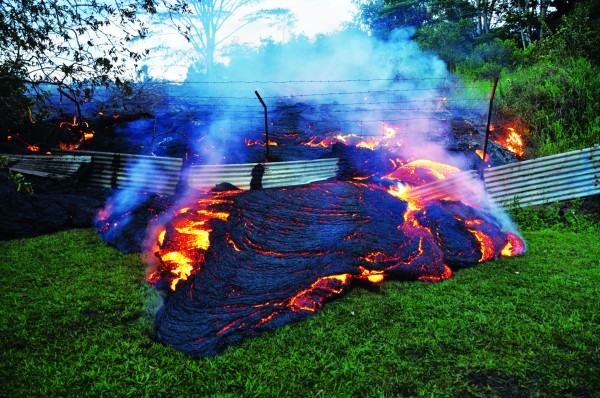11 November 2014
Scientists Engage With the Public During Lava Flow Threat
Posted by mcadams
By Tricia McCarter
On 27 June, lava from Kīlauea, an active volcano on the island of Hawai`i, began flowing to the northeast, threatening the residents in Pāhoa, a community in the District of Puna, as well as the only highway accessible to this area.
Scientists from the U.S. Geological Survey’s Hawaiian Volcano Observatory (HVO) and the Hawai`i County Civil Defense have been monitoring the volcano’s lava flow and communicating with affected residents through public meetings since 24 August.
Eos recently spoke with Michael Poland, a geophysicist at HVO and a member of the Eos Editorial Advisory Board, to discuss how he and his colleagues communicated this threat to the public.
Eos: What is the status of the lava flow right now?
Poland: As of Friday morning [31 October] local time, the flow front has stalled. It’s about 155 meters from Pāhoa Village Road, which is the main street through Pāhoa. There are a lot of breakouts of lava above that point, but the leading edge of the flow is not presently pushing downslope. That’s not likely to be the case forever, but there’s at least a temporary halt in the advance of the flow for now.
We expect that it will probably change as time goes on. That’s the way this flow has behaved in the past several weeks: It advances and then stalls, which seems to be the normal life cycle of this particular flow and pāhoehoe flows in general.
Eos: What kind of damage has happened to the area?
Poland: Thus far no homes have been destroyed. The flow has burned a farm shed and cattle structures, and it has traversed some private land, where it has destroyed much of an orchard. There is a cemetery above Pāhoa that was inundated by lava. Also, a few weeks ago the lava ignited brush fires, but they were quickly put out by the Hawai`i County Fire Department. In residential areas, the fire department is standing by to prevent any widespread fires.
Eos: How did you know it was time to start alerting the public about the threat of a lava flow to their neighborhoods?
Poland: It became fairly clear early on based on where the flow was located and the rate of advance that it was heading toward the island’s Puna District. While difficult to tell exactly where the lava would go, we are able to broadly forecast the direction of flows based on topography, and it was clear that it was moving toward Pāhoa.
What made this flow special—and we’ve had flows in this area before that have pushed in this same direction—was that its initial advance rate was quite high. The flow, confined by older flows, was quite narrow at first, which allowed it to move quite quickly.
As we tracked the flow’s direction, and once it became clear that it was moving quickly, we issued a press release on 22 August to alert the community to the potential hazards it posed. The release was distributed to local news outlets and beyond.

Michael Poland, a geophysicist at the U.S. Geological Survey’s Hawaiian Volcano Observatory, discusses how they warned the public about the threat of lava flows from Hawaii’s Kīlauea volcano. Photo credit: USGS
Eos: What has been the most effective medium you have used to communicate the threat to the public?
Poland: I think the most effective thing we’ve done is to participate in a series of regular community meetings organized and run by the Hawai`i County mayor’s office and Civil Defense. Initially, multiple meetings were held each week, but the county is now holding weekly meetings in Pāhoa. In addition to these large community meetings, HVO participated in other Hawai`i County–led meetings specifically for nearby residential subdivisions.
The meetings have reached a tremendous number of people, with attendance often 300–400 people and occasionally exceeding 600. The meetings, usually Webcast via local online news sources, include a lava flow update by an HVO scientist, as well as briefings by the civil defense director and the mayor, who provide updates on what county agencies are doing to mitigate the impacts. After these presentations, additional HVO staff, along with various representatives from other agencies and organizations, are available to answer questions from the public. This has been an effective way of interacting with the community because it’s one-on-one communication with the people who are directly impacted by this lava flow.
Eos: Was it difficult to explain the science behind the lava flow to the public?
Poland: Many long-time Hawai`i residents have been following HVO’s daily eruption updates for decades and are quite knowledgeable about the volcano. But at first, it was a little difficult to communicate with the public because there was, in some cases, a bit of a gap between the concepts we were trying to explain and the public’s ability to perceive what we were saying.
However, it’s been amazing to watch the public’s level of understanding increase over the past 2 months. So something like the inflation and deflation cycles of Kīlauea might have initially been a foreign concept to many people attending the meetings. After hearing about it at the weekly meetings, some of those people are now looking at deformation data on our website with a better understanding of what it means. They’re also asking very specific questions at the community meetings, such as, “Do you think the deflation that’s happening right now will affect the lava flow?” To us, this attests to the value of the weekly meetings.
Eos: What kind of response did you get from the public once you started sharing information about the lava flow and the threat to their homes?
Poland: Initially, there was an element of shock that the lava flow was heading in their direction. There has also been a sense of frustration because the flow advances in fits and starts, moving forward about 400 meters a day and then stopping for days. Then it would advance 100 meters a day and stop again. So it was frustrating for the public because it wasn’t something that could be forecast with any great accuracy.
Eos: What advice would you give to other scientists who may have to communicate a complex situation to the public?
Poland: I don’t think there’s a one-size-fits-all approach. You need to identify your target audience and determine the best way to deliver your message clearly and concisely.
But I also don’t think we should assume that our audience is unable to grasp difficult concepts. They’ve shown us that they are capable of learning about how volcanoes work, especially over a prolonged disaster such as this. It provides an opportunity to educate people as best we can. I’m gratified by that, because they can take a more active look at their own environment, and I think that’s a good outcome of this.
—Tricia McCarter is a Staff Writer for Eos.
This story first appeared in the 11 Nov. 2014 issue of Eos.



 The Plainspoken Scientist is the science communication blog of AGU’s Sharing Science program. With this blog, we wish to showcase creative and effective science communication via multiple mediums and modes.
The Plainspoken Scientist is the science communication blog of AGU’s Sharing Science program. With this blog, we wish to showcase creative and effective science communication via multiple mediums and modes.